|

N A V I G A T I O N



Home 



About
King Quack Jr
 

Family Pictures
 

eBay Auctions
 

My
Collection
 

Decoy Carvers
 

Shell Boxes



Deer Hunting
 

Duck Hunting
 

Hunting Videos



Vintage Photos



Articles



Hunting Humor
 

Links



eMail
 
|
Please note, the
pages of this website contain numerous graphics.
If you are using dial up connection, it may take a few
minutes for the pages to fully load.
Thank you for your patience. |

|
Are you looking for a particular decoy? Do you have a decoy to
sell or trade? If so, please email Vince at: decoylover@att.net |

|
|
White Mallard/Ward Brothers Decoys
The White Mallard ranks as one of the most famous duck clubs on the
Pacific Flyway. It’s located in the Butte Sink, Colusa County, right
in the middle of the 500,000 acres of Northern California rice land.
The White Mallard consists of 969 acres, about 90% of which is
dedicated to wetland habitat. One hundred acres of wetland is
located in the middle of the club and is designated as a
non-shooting area. The White Mallard is also located in close
proximity to eight state and federal game refuges.
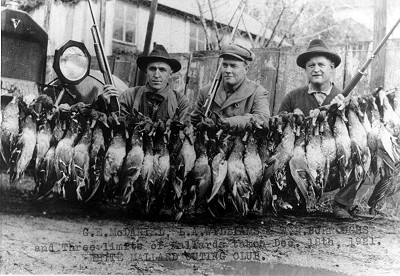
The duck club formed
in 1919 and was originally called the White Mallard Outing Club.
According to the grandson of Gilbert Williamson, one of the original
members, 100 people put up $100 each to buy the property. The first
hunters had to walk in or push a tule splitter two miles to get to
the shooting area. They hauled all their gear and supplies in and
out without using a vehicle or boat motor.
The White Mallard is
also well-known by decoy collectors because of the fine Ward
Brothers decoys that were used at the club. In 1936 William
Burroughs Sr., a building contractor and an original member, was
hired by Errol MacBoyle to build two large redwood horse barns in
Grass Valley, California. Burroughs briefly moved his family from
Marysville, California to Grass Valley to fulfill his contract.
MacBoyle lived in San Francisco and owned the Idaho-Maryland Mining
Company in Nevada County. At the time his company was the third
leading gold producer in California. In 1933 MacBoyle constructed
the original airport in Nevada County. He hired local youths on
summer vacation to prepare the 1800 foot air strip. That same year
MacBoyle used the air strip to fly 27 million dollars worth of gold
from Nevada County directly to Mills Field (later SFO) en route to
the San Francisco Mint.
MacBoyle and Burroughs
became good friends and began duck hunting together. Although only
marginally interested in the hunting itself, MacBoyle joined the
White Mallard sometime between 1936 and 1938. To complete his
hunting equipment, he bought a rig of an unknown number of Ward
Brothers decoys, perhaps as many as seven dozen, in the late 30s.
These decoys were reportedly purchased in San Francisco, possibly
from Abercrombie and Finch but more likely from the Roos-Atkins
Store.
When MacBoyle passed
away in 1949 his chauffer, Hardy Jenny, inherited his membership.
Jenny shared a hunting cabin and storage shed with Burroughs and
later with his son, William Burroughs Jr. According to Mike
Burroughs, the son of William Burroughs Jr, Jenny also enjoyed
socializing but did quite a bit of duck hunting and was usually at
the club every weekend during duck season. Mike remembers the Wards
Brothers decoys being stored in the shed that his dad and Jenny
shared. During duck season Jenny kept the decoys in his duck boat as
was common practice for members. The frequency of use of the Ward
Brothers rig during this period, from the late 30s to 1960, is
unknown. However, based on the indications of wear and tear
(including shot marks) on many of the survivors, the decoys were
used regularly for a considerable period of time. Mike Burroughs
stated that with the introduction of plastic decoys, Jenny stopped
using the heavy Ward Brothers decoys and switched to plastic.
Undoubtedly, a portion of the original rig had been lost or
destroyed by that time. The remainder of the rig stayed in the shed
for a few years and then eventually started to disappear. A dozen or
more appear to have been taken by caretakers or early collectors. A
few of the remaining birds in the rig were kept by the Jenny family
(reportedly 8 to 10), and the remainder were given by Jenny to
William Burroughs Jr.
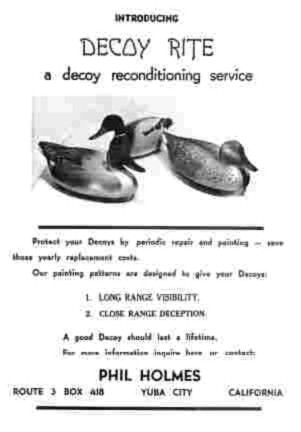 After
his father passed away, William Burroughs Jr. took over his
membership in the White Mallard. His brother-in-law, Phil Holmes,
raised peaches outside of Yuba City, California. Holmes was not a
member of the White Mallard but would on occasion hunt with
Burroughs at the club. In 1960 Holmes suffered a heart attack and
was unable to do any strenuous work; as a result, he started a decoy
repair business called Decoy Rite. He occupied himself by repairing
and repainting duck decoys for the local duck clubs, but never
showed an interested in carving. He repaired and painted decoys for
a number of Northern California duck clubs including the Sacramento
Outing, South Butte Club, Field and Tule Club, Greenhead Land
Company, Murphy Land Company, Burgundy Club, Poc. Valley Land
Company, Moro Island Gun Club, Oak Hill Farms and of course the
White Mallard. After
his father passed away, William Burroughs Jr. took over his
membership in the White Mallard. His brother-in-law, Phil Holmes,
raised peaches outside of Yuba City, California. Holmes was not a
member of the White Mallard but would on occasion hunt with
Burroughs at the club. In 1960 Holmes suffered a heart attack and
was unable to do any strenuous work; as a result, he started a decoy
repair business called Decoy Rite. He occupied himself by repairing
and repainting duck decoys for the local duck clubs, but never
showed an interested in carving. He repaired and painted decoys for
a number of Northern California duck clubs including the Sacramento
Outing, South Butte Club, Field and Tule Club, Greenhead Land
Company, Murphy Land Company, Burgundy Club, Poc. Valley Land
Company, Moro Island Gun Club, Oak Hill Farms and of course the
White Mallard.
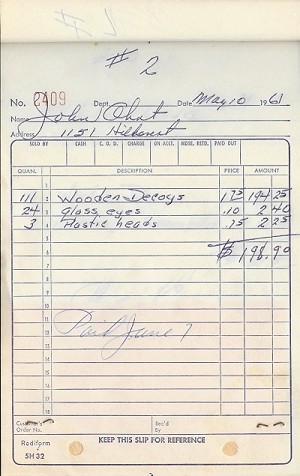 On
a number of occasions Holmes saw the Ward Brothers decoys at the
White Mallard and was impressed by their workmanship. Holmes told
Burroughs that he was interested in obtaining the decoys. In
December 1960, Burroughs brought Holmes quite a Christmas present
when he gave him about 40 of the decoys. Holmes, in return, gave
back to Burroughs a set consisting of each different style. This set
has since been sold to a private collector. On
a number of occasions Holmes saw the Ward Brothers decoys at the
White Mallard and was impressed by their workmanship. Holmes told
Burroughs that he was interested in obtaining the decoys. In
December 1960, Burroughs brought Holmes quite a Christmas present
when he gave him about 40 of the decoys. Holmes, in return, gave
back to Burroughs a set consisting of each different style. This set
has since been sold to a private collector.
The Ward Brothers rig
given by Burroughs to Holmes consisted of Sprigs and Mallards. Using
nomenclature found in Gard and McGrath book (The Ward Brothers
Decoys, 1989), the rig consisted of a Classic 1936 Pinched Breast
Sprig, a Classic 1942 Sprig (which during Holmes’ ownership became
known as “lessor sprig”), and Mallards in the 1936 to 1942 genre not
otherwise identified. The group was about evenly distributed between
hens and drakes of the three styles, although only three pinched
breast hen Sprigs can be confirmed to have been included in the rig
by tracing the records now available. Gard and McGrath indicate that
although the name “1942” has been given to a style, the actual date
of production can vary. There is no evidence that portions of this
rig were purchased at different times. The different styles appear
to have been produced in the 30s and included together in one order.
The “Andy Williams” pair clearly came from this rig and the “1942”
Classic Pintail Drake pictured as Plate 60 in Gard and McGrath is
identical to others confirmed to have been in the rig. The Mallard
drakes are very similar to the “1942” Classic Mallard Drake shown in
Plate 75 of that book. No examples of hens matching either the 1942
Sprig or the Mallard are shown in Gard and McGrath book. The body
painting on both the Mallard and Sprig hens in this rig, are
surprisingly similar to each other and had elements of many
different Ward hens painted in the 30s and 40s. However, the hen
Mallards are much larger than the Sprig and the sizes obviously
match their counterpart drakes.
Over the years, some
of the decoys made their way to auction, which led to some
controversy. Many Ward Brothers decoys, included Wigeon, were
attributed to the “White Mallard rig.” As reported in Gard and
McGrath and confirmed by the Holmes family, all the Ward decoys
given to them had a lead balance weight shaped like a horseshoe. The
weight was nailed around the back end of the bottom of the decoy.
MacBoyle loved horses, which may explain why all the lead balance
weights were shaped like a horseshoe (see photo). If any of the Ward
Brothers decoys sold at auction did not have the horseshoe weight or
the nail pattern of a horseshoe weight, they probably did not come
from MacBoyle’s rig. There is no indication that any other White
Mallard members ever owned Ward Brothers decoys.
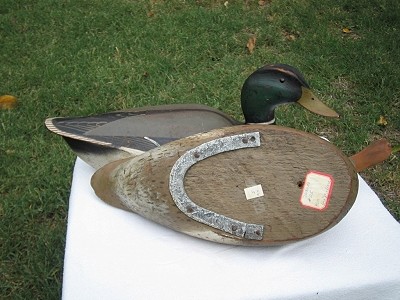
Holmes eventually
obtained other Wards Brothers decoys not associated with the White
Mallard. These decoys were of later vintages and were obtained by
trade or as payment for his work. It also appears that he obtained a
few classic decoys as part of his reconditioning business, including
a rig made by “Fresh Air Dick” Janson.
There also was a small
Ward Brothers rig that ended up with a few members of the Sacramento
Outing. These decoys may have come from the White Mallard, but I
have not seen the bottom of any of the decoys to verify the
horseshoe pattern. Sometime in the 1960s, Holmes was approached by a
member of Sacramento Outing who wanted to sell eight Wards Brothers
decoys that he said came from the White Mallard. Holmes did not
purchase these decoys due to their poor condition.
Some members of the
Holmes family feel that decoys from the original Ward Brothers White
Mallard rig have not been accounted for. It appears that some of
those fine decoys may be hidden away somewhere, probably in Northern
California.
NOTE: Holmes and his family sold
or traded most of the original group, although a few remain in the
family and are not for sale. Any information on the White Mallard or
Ward Brothers decoys used at the White Mallard would be greatly
appreciated. You can contact me at
decoylover@att.net
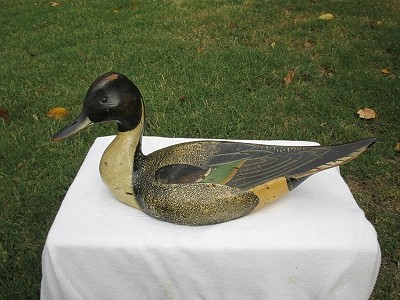
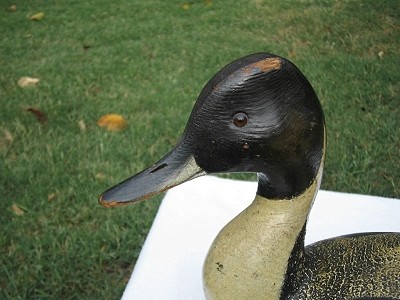
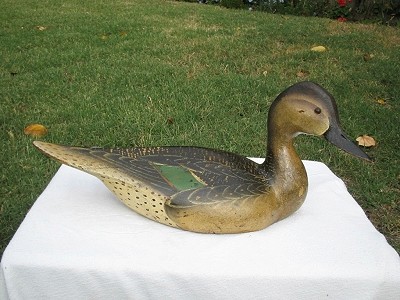
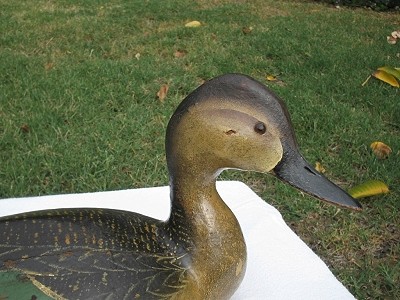
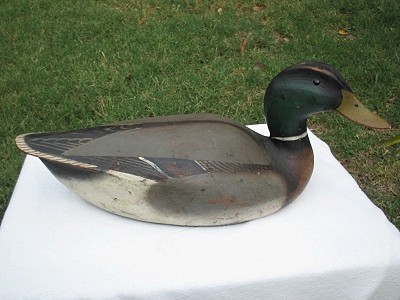
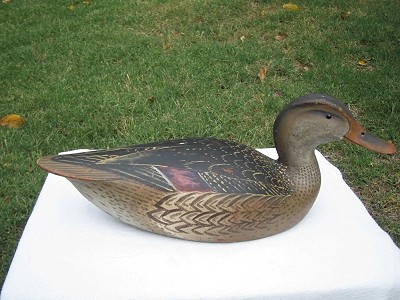
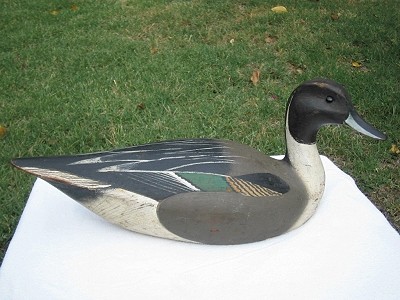
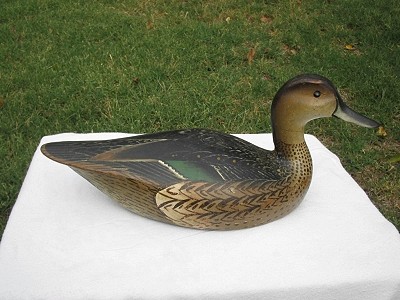
To download this article in PDF
format please click below:

You must have Adobe Acrobat
Reader installed on your computer in order to view the downloaded
article. Click below to get it for free.

|
 |